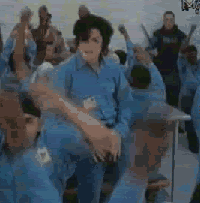|
|
Posted: Tuesday 20 October, 2009
Michael R. Thomas
Editor’s note: This summer, make-up artist Michael Thomas and pop star Michael Jackson died within two months of each other (Thomas’ obituary is posted on our site). Here, Thomas, who was Jackson's make-up artist for The Wiz, recalls some memorable experiences with Jackson on and off the set. Thomas’ wife, Christine Domaniecki, shared Thomas’ memories with us.
Wizardry Behind The Wiz
On The Wiz, we had Vac-u-Forms made from plaster life masks of each actor who appeared as a main character (including the Cowardly Lion, the Tin Man and the Scarecrow, played by Michael Jackson). They were made because every week or so, Stan Winston’s Los Angeles-based lab would ship a bunch of the actors’ freshly made foam-latex appliances to New York, where we shot the movie.
After I brought the Scarecrow appliances home, I would lightly attach the foam-latex pieces to the Vac-u-Form and pre-color them. It saved a lot of application time when we were in the make-up room at the Kaufman Astoria Studios. Keeping the foam-latex pieces on the form during pre-painting kept them in shape, the way a coat hanger keeps wrinkles out of a coat. On the inside of one of the forms, you can see a few color swatches. I duplicated the color of the Scarecrow's greasepaint in artists’ acrylic. I put acrylic on the neck ruffle he wore as well, because if I used greasepaint, it would rub off onto his costume.
We were allowed to keep the forms at the end of the movie. I have about five.
Every morning I began Michael’s make-up by applying a bald cap to keep his hair, which was in very small braids, in place. Next I would apply the foam-latex pieces: a forehead piece, two cheek pieces, a nose piece (which was supposed to look like a Reese's Peanut Butter Cup wrapper), a chin piece and a neck ruffle. They went on in the morning and had to be maintained during the day.
Because the Scarecrow was a very cartoon-y character, Michael made lots of exaggerated facial expressions to bring the Scarecrow to life. The facial calisthenics looked great, but they also loosened the foam-latex pieces, so I would have to re-glue and re-paint the make-up (for more on this, see the Martini Shot in Issue 81 of Make-Up Artist magazine). To remove the make-up at the end of the day, I would stand behind Michael, lift the back of the bald cap and peel it up over his head. The cap and the foam-latex appliances would come off pretty much all in one piece.
But then I’d duck down behind his chair so he couldn't see my reflection in the mirror, put the make-up (which now looked like a spooky mask) on my hand, slowly raise it up behind his head and jiggle it, going, “OOODLE-OOODLE-DOOODLE-DE-OOOOHHH!” He would laugh like crazy, as if it were one of the funniest things he'd ever seen. I really enjoyed his childlike sense of humor; I could say or do any dumb thing and it would get a big laugh. I would then remove the remainder of his make-up, glue and adhesives and that would be it. We’d go home and get ready for the next day's shooting.
Fun and Games
When we were talking one day, I told Michael that when I was a little boy, I taught myself how to draw, which was pretty much the beginning of my becoming a make-up artist. He asked to see an example. I took a pen and drew a quick sketch of the Frankenstein monster. He liked it. He said that he and his brothers and sisters sometimes played a game to fight boredom: One of them would draw a few abstract lines on a piece of paper, give it to another sibling and say, “OK, now make a fire engine out of this, or a tree,” etcetera, and the other sibling had to complete the drawing in a certain amount of time.
When I played the game with Michael, I tried to trick him by drawing a few curvy lines that I felt did not suggest a cat. As far as I was concerned, these curvy lines looked nothing like a cat. So I said, “Go ahead, make a cat out of these lines!” And within 30 seconds he had drawn a cat. Not as I would have pictured one, standing on all fours, but a pussycat curled up asleep.
Then he made a couple new drawings on the spot, and I kept them with his blessing. One of the drawings was of a man’s face. It’s pretty sketchy and kind of impressionistic, but there are a couple of eerie similarities between the drawing he made and his own face, later on, after he had so much plastic surgery done.
On the Outside
There's a phenomenon that frequently occurs when a make-up artist and an actor work together: instant intimacy. Make-up artists and hairstylists are kind of like psychiatrists or bartenders. You’re in the same room, physically close for hours at a time, sometimes for many days. Because people usually have the urge to talk, the subject matter often changes from chitchat to some very serious subjects. And though the two of us were only together to work on a movie, we got to know each other pretty well.
I asked Michael over for dinner one night. We had to keep quiet about it, because if anybody found out, word would spread like wildfire. It was 1978 and at age 19, Michael was already well-known around the world. So he came over to our apartment in Bergenfield, New Jersey with his armed bodyguard, Spence. Dinner was Cornish game hens and, by Michael’s request, Stove Top Stuffing, which he said the folks in his home town of Gary, Indiana referred to as “dressin’.” When he ate, he really dug in: He got food all over his face, all over the table, all over his clothes. He was very passionate about anything he did, and I suppose eating was one of those things.
We had a great time that night. Because I play guitar a little, I showed him how to play some easy chords on my acoustic guitar. He had always admired people who could play musical instruments and had often fantasized about being the lead guitarist in a rock band.
At that time, the comedian Robert Klein had made an appearance on Saturday Night Live; he came out with a harmonica, gave the band the downbeat by stomping his foot, and cried, “Lemme hear some blues!” The band struck up the introduction to a blues number and he began playing the harmonica with them, stomping his feet, leg pumping in time. After the opening 16 bars, he pulled the harmonica from his lips and, foot still stomping, sang, “I can't stop my leg, little darlin’ ... I can't stop my leg, little guurrl!” Well, Michael got a big kick out of this. So while I played a blues chord progression on my guitar, Michael stomped his foot and sang, “I can’t stop my leg!” At one point while he was singing, he said, "Now listen to me, people” and I broke up because he was really getting into it. From this visit, I got the sense that he was a very normal, healthy kid.
So I got to know the great Michael Jackson a little. He told me once that whatever he happened to be doing—working on a movie, cutting a record, appearing live on stage—it was the most important thing in his entire life while he was doing it. It really showed. No matter what he was doing, his talent spoke—and sang, and danced—for itself.
Michael was a very special person whose life was a combination of extremes. He enjoyed normal, down-to-earth things, but he also earned lifetime membership to a very exclusive club. His talent, tempered by lifelong discipline, reached the hearts of countless admirers and reshaped music for all time. He was denied his childhood; I think he spent the rest of his adult life trying to live it for the first time. He was a big kid!
高人翻译一下.很想知道是什么故事. |
|


